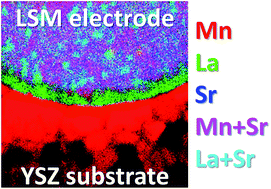Dynamic behavior of impurities and native components in model LSM microelectrodes on YSZ†
Abstract
Strontium-doped lanthanum manganite is a widely used cathode material in solid oxide fuel cells. Segregation phenomena can have a critical impact on performance and durability, especially when they cause active interfaces to degrade. The segregation behavior in polarized and non-polarized strontium-doped lanthanum manganite ((La0.75Sr0.25)0.95MnO3) microelectrodes with a diameter of 100 μm and a thickness of ∼500 nm on an yttria-stabilized zirconia electrolyte were analyzed post-mortem after ∼200 h at temperatures up to 850 °C. Time-of-flight secondary ion mass spectrometry was used to study the dynamic behavior of the native components (La, Sr, Mn) and selected impurities (Si, K, Na) both laterally and in-depth. Manganese was found to be especially mobile and showed both segregation onto the electrolyte as a result of temperature and polarization and dissolution into the electrolyte below the microelectrodes. All native components showed a complex in-depth dynamic behavior, and a nanoscale in-depth analysis of the electrode–electrolyte interface revealed the formation of a well-defined lanthanum zirconate layer. The selected impurities segregated to the electrolyte and microelectrode surfaces and Na- and K-rich layers formed at different depths.



 Please wait while we load your content...
Please wait while we load your content...